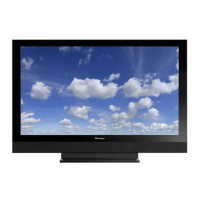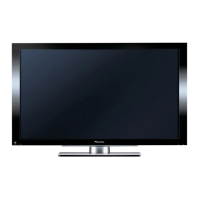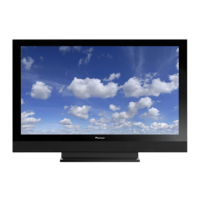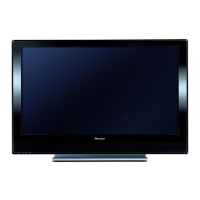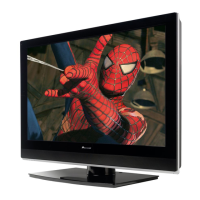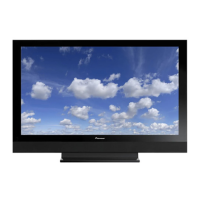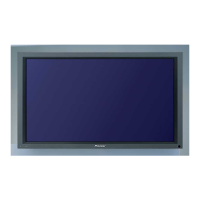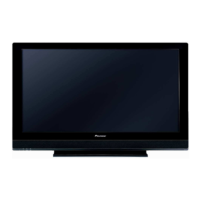
Do you have a question about the Pioneer PDP-5080XA and is the answer not in the manual?
| Depth | 15 mm |
|---|---|
| Width | 1224 mm |
| Height | 717 mm |
| Weight | 34400 g |
| I/O ports | 1 x RCA AV |
| Tuner type | Analog |
| Audio system | SRS, TruBass |
| Product color | Black |
| Noise reduction | Yes |
| RMS rated power | 17 W |
| Display diagonal | 50 \ |
| Display language | CZ, DK, NL, EN, FN, FR, DE, GR, IT, NR, PL, RU, SP, SE, UA |
| Channels quantity | 999 channels |
| Composite video in | 1 |
| Display resolution | 1365 x 768 pixels |
| Display technology | Plasma |
| Power requirements | AC220 - 240V, 50/60Hz |
| SCART ports quantity | 3 |
| Contrast ratio (typical) | - |
| Power consumption (standby) | 0.3 W |
| Power consumption (typical) | 361 W |
Emphasizes the mandatory earthing of the apparatus for safety.
Instructions for safely replacing the fuse in the power plug.
Notes on complete power shutdown and ventilation requirements.
Explains symbols indicating hazards and important instructions.
Describes the function of the standby/on button and indicator.
Precautions to avoid image retention and screen burn-in.
Recommendations for safe and stable installation.
Explains screen dimming for protecting against static images.
Details on pixel defects and when to contact support.
Notes on potential interference with remote controls and headphones.
Information on potential interference and operational sounds.
Instructions for cleaning and handling the product.
Guidance on preventing issues from temperature changes.
Methods to prevent image retention and screen damage.
Essential safety rules for operating and cleaning the unit.
Precautions for secure installation and preventing falls.
List of remote control unit and included batteries.
Details on power cable, screws, and plastic bands.
Includes ferrite core, cable tie, speed clamps, and cleaning cloth.
Identifies front panel and side input/output terminals.
Identifies rear input/output terminals for different models.
Details the function of each button on the remote control.
Instructions for physical setup and location considerations.
Guidance on safely handling and moving the unit.
Methods to secure the television to prevent tipping.
Procedures for mounting and dismounting the television stand.
Steps for connecting the antenna and routing cables.
Instructions for inserting batteries and understanding operating range.
How to switch the TV on and put it into standby mode.
Methods for selecting TV channels and favorite channels.
How to adjust audio levels and mute the sound.
Function to capture and hold a video frame.
Introduces the main menu structure and navigation.
Step-by-step guide to accessing and changing menu settings.
Automatic search and setup of TV channels.
Manually adjusting frequency, system, and colour settings.
Adjusting settings to reduce noise in broadcast signals.
Naming channels and changing the order of stored TV channels.
Setting on-screen display language and viewing modes.
Adjusting contrast, brightness, color, and sharpness.
Detailed settings like PureCinema, Intelligent Mode, and Picture Detail.
Customizing treble, bass, balance, and sound effects.
Managing energy saving and auto-off features.
Selecting drive mode based on program type.
Manually adjusting horizontal and vertical image placement.
Automatic and manual adjustment for PC image and clock.
Optimizing settings for gaming and adjusting display aspect ratio.
Managing side masks for 4:3 content and adjusting brightness.
Adjusting indicator brightness, screen shifting, and auto-off timers.
Setting, changing, and disabling security passwords.
Steps for connecting DVD players, decoders, VCRs, and PCs.
Details on connecting devices via HDMI for video and audio.
Features for smooth connections with other audiovisual equipment.
Explanation of controlling connected Pioneer devices via HDMI.
Procedures for connecting AV amps, recorders, and players.
Configuring input terminals, power-on/off, and sound status.
Navigating menus for playback, recording, and system control.
Introduction to Teletext services and broadcast information.
Turning Teletext on/off and navigating basic pages.
Accessing hidden info, TOP Over View, and subtitles.
Solutions for power, operation, sound, and picture problems.
Specific issues related to HDMI control functions.
Technical details for D-sub and SCART connectors.
Technical data including pixel count, power, dimensions, and trademarks.
